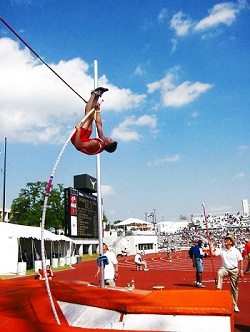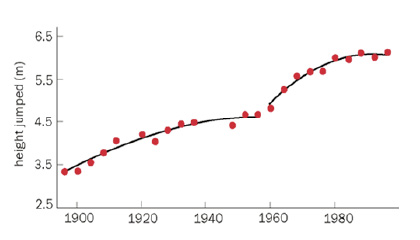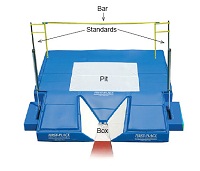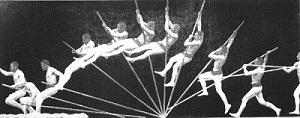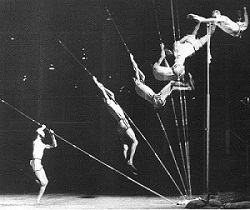Pole vaulting is an incredibly dynamic and complex sport that requires high levels of athleticism, precision, and skill. The process of the vault involves the transfer of energy from the vaulter to the pole, and finally back to the vaulter as he is launched into the air. As a result, the vault relies heavily on the efficiency of energy transfer back and forth between the vaulter and the pole. Since the inception of competitive pole vaulting in the mid-19th century, the sport has seen dramatic changes in both technique and technology that address these efficiency concerns. Poles were originally constructed from hardwood, but soon changed to bamboo and finally fiber-glass, the material of poles used today. While these materials have revolutionized the vault and taken it to soaring new heights, there are some limitations for future advancements as we reach the peak of materials technology and boundaries of athletic performance.
Imagine running at full speed carrying a 15 foot long pole. You approach a large foam mat and a high bar spanning across two rigid standards. Once you are a few feet away from the mat, you lower the front tip of the pole into a hole in the ground, raise your arms up towards the sky, and jump as high as you can. In less than a second, the pole bends and you swing your legs up above your head so that you are completely upside-down. Your body is launched upwards, and once the pole fully recoils, you let go and suddenly find yourself floating 17 feet above the ground. Just as quickly, you plummet back towards the earth and come to rest comfortably in the middle of the foam mat (for illustration, see Fig. 1)
You have just successfully completed a pole vault, one of the most dynamic track and field events in modern competition. The sport requires an all-around athlete with the speed of a sprinter, the jumping abilities of a high jumper, and the strength of a thrower. Unbeknownst to many, pole vaulting also requires an engineer to develop pole technology to efficiently absorb and transfer energy. The result is a gravity-defying phenomenon in which vaulters seem to soar effortlessly into the air.
A Brief History
Pole vaulting, in its non-competitive form, has existed since the days of the ancient Greeks, when it was used to surmount obstacles such as enemy walls or to vault over or onto animals such as bulls and horses [1]. In 1775, poles were implemented into gymnastic competitions in Germany for a vertical jump event. Finally, in 1850, the first “running pole leaping” competitions were held, and since then, the sport has grown to become a staple of high school, collegiate, and international-level competitions [2].
The Process of Pole Vaulting
The vault is a complex, yet seemingly fluid and graceful process that utilizes almost all of the core muscles of the body and requires a large amount of practice and skill. For the purpose of explaining how pole vaulting works, this complex process can be broken down into four basic steps: the approach, the plant/take-off, the swing-up, and the push-off.
The approach allows the athlete to build up speed and prepare for the plant and take-off. The vaulter starts from a standing position, places his hands spaced apart at one end of the pole, holds the pole in a vertical position, and then slowly lowers the tip of the pole as he approaches the box and pit. During the plant/take-off, the vaulter lowers the pole tip into the back of the box, raises his arms up above his head (with the left hand about a foot farther forward on the pole for a right-handed person), and jumps up off the ground while still maintaining his forward momentum. These actions result in the pole bending and gaining energy, which will later be used to propel the vaulter upwards (Fig. 2). During the swing-up, the vaulter swings his legs up over his head towards his hands, bringing his body upside-down and in line with the pole. Once upside-down, he “pulls” the pole against his body and past his head, performing a handstand on top of the pole. This then leads to the final step, the push-off, in which the vaulter throws himself off his pole and curls himself over the bar, while at the same time rotating his body so his stomach is facing towards the ground. These movements allow the vaulter’s body to contort over the bar with more ease. Finally, the vaulter falls back to the pit and comes to rest on his back [3].
The Physics Behind the Vault
[flash=401 file=”thumbnail-200x125.jpg” placement=”right”]Figure 3: Pole vaulting interactive flash demo.[/flash]Pole vaulting relies on finding the most efficient way to transfer energy among different energy states. These states are kinetic energy, or the energy associated with the motion of an object, and two different types of potential, or stored, energies: elastic potential energy and gravitational potential energy. Elastic potential energy is the “energy stored in elastic materials [in this case, the pole] as the result of their stretching or compressing,” while gravitational potential energy is the “energy stored in an object as the result of its vertical position or height,” [4]. During the vault, the kinetic energy built up during the run (KEapproach) is transferred into elastic potential energy due to the bending of the pole (PEpole.) Then, that potential energy is transferred into kinetic energy as the athlete is vaulted upwards (KEvault.) As the athlete rises above the ground, this kinetic energy is transferred to gravitation potential energy (PEpeak) until the athlete is not moving any higher. Finally, this potential energy is turned back into kinetic energy as the athlete hurls towards the ground (KEfall.) Thus, the pole serves as a tool for converting the athlete’s horizontal kinetic energy into vertical kinetic energy. Equation 1 shows a symbolic progression of this process and Fig.4 highlights the energy changes in an animated example.
KEapproach -> PEpole -> KEvault -> PEpeak -> KEfall(1)
Through the transfer of energy, a vaulter is able to launch himself up to 20 feet in the air, depending on his speed and weight. The greater the vaulter’s speed and mass, the more momentum he can build up during his approach, and thus the more energy he can transfer into the pole. Using a man with a center of mass 1.0 meter off of the ground who can run with a speed of 10 meters per second as an example (values for an elite athlete), the formula predicts that he should be able to vault about 6.10 meters high [5]. This result is surprisingly accurate, considering that the world record is currently set at 6.14 meters, a mark achieved by Sergey Bubka of Ukraine in the early 1990s. The slight differences between the theoretical and actual heights have to do with the pole’s efficiency in transferring energy, which will be discussed later.
The Evolution of the Vault
As with any sport, track and field athletes always strive to push the boundaries of athletic performance and progress, pushing every event towards faster times and higher heights. Modern athletes have been able to achieve much higher levels of performance than athletes of the early 20th century. As evidence, we can consult a list of worldwide track and field records and notice that the best marks for every single event were set in 1981 or later, with most occurring in the 1990s and 2000s [6]. The evolution of competitive pole vaulting has been aided by three factors: improved athleticism of athletes, improved training techniques, and most importantly, the evolution of pole technology.
Athletes have trained to become stronger and faster than their predecessors. Speed, strength, and explosiveness play key roles in determining how high a competitor can vault. There has also been an increased emphasis on multi-faceted training for high-level and elite vaulters, especially due to the complexity of the event. Hence, workouts now include a combination of vaulting, sprint workouts, plyometrics (exercises used to strengthen fast-twitch muscles), core workouts, high bar workouts, and power lifting. Additionally, vaulting techniques have advanced since the sport began, from a pole-climbing method used in the early days of vaulting to the swing-up technique used today. These advancements have resulted in an increased potential for maximum vault height. The progression of pole vault records can be seen in Fig. 4, which shows an increase in heights along with time throughout the past century.
A Shift in Focus from Athlete to Pole
Despite advancements in the physical potential of athletes and in training techniques, the most important factor towards advancing the sport has been the development of better pole materials. Research into these new materials led to the change from a straight-pole method of vaulting to the bendable pole method used today, and in doing so inadvertently shifted the focus of the vault from the athlete to the pole.
In modern pole vaulting, an extremely important part of the vault undoubtedly involves the pole. The vaulter relies on the pole to absorb as much energy as possible and then transfer that energy back to vault him into the air as high as possible. The more efficiently the pole can absorb and transfer this kinetic energy, the higher a vaulter can travel. Thus, due to the significant effect of pole efficiency on vault height, engineers and scientists have researched and developed new materials and technologies for poles.
As shown in Fig. 3, with the introduction of the bamboo pole in the early 1900s and the subsequent introduction of the glass-fiber pole in the early 1960s, Olympic vault heights increased more dramatically in the years following. The ideal situation is to use a pole that will transfer energy with 100% efficiency. Realistically, however, this goal is unreachable due to imperfections in materials (from a visible crack all the way down to a fault at the microscopic level) and limitations on the physical properties of materials. Nonetheless, due to extensive research and testing, modern poles have come as close to near perfect efficiency as technology will allow today.
Additional properties of the pole that play a role in the vault are the pole’s responsiveness and weight. Newer materials respond more adeptly to bending and spring back to their unbent positions more quickly and with more force, thus “throwing” the vaulter higher, farther, and faster. The weight of the pole also affects the vault, as lighter poles allow the athlete to sprint faster and complete the plant with ease, while heavier ones require more effort. Evolutions in pole technology thus allow athletes to fly to incredible heights never imagined when the sport was invented. The evolution of materials from hardwood, to bamboo, and finally to fiberglass and carbon fiber, validates the strong influence of material properties on the success of the vault.
Evolution of Pole Materials
Hardwood (Ash or Hickory)
When pole vaulting competitions began in the mid-19th century, the poles that were used were made of heavy, rigid hardwood such as ash or hickory. The athlete would climb the pole after he planted and jumped, and throughout the vault, the pole remained rigid and had essentially no bend. The basic technique of the hardwood pole vault can be seen in Fig. 5. In 1889, American vaulters banned the pole-climbing technique and implemented the swing-up technique, an early version of the modern method , which added height to the vault [7]. Despite the advancement in technique, however, the hardwood poles were limited because they could not bend. As a result, the poles could not transfer horizontal motion into upward motion efficiently, as a large amount of energy was lost in the plant and vaulters were constrained to lower heights.
Bamboo
Around the same time that the swing-up method was introduced as the definitive technique in the vault, bamboo poles began to replace the hardwood ones. The swing-up necessitated a new type of pole that had some bend, and bamboo fulfilled that need. Also, the box was introduced into the plant stage (previously vaulters had simply stuck the pole in the ground), which required the pole to have some bend as well. The swing-up technique can be seen in Fig. 6, where a vaulter uses one of these new poles to clear a height. Bamboo poles were much lighter than the solid ash or hickory poles due to the fact that bamboo is naturally hollow, which allowed for a faster approach. Additionally, these poles had a lesser degree of stiffness and thus had a minor ability to bend when stressed. For these reasons, vaulters were able to carry more energy into the vault and convert more energy into an upward motion.
By 1942, the world record, set on a bamboo pole, was recorded at 4.77 meters [2]. However, the bamboo pole still presented limitations to achieving higher heights. The pole still did not bend enough to significantly increase the efficiency of the vault and a large portion of energy was wasted once again on the plant. Additionally, bamboo is weaker (can take less stress/bending before breaking) than both the hardwood poles used before it and the fiber-glass poles used after, so vaulters could not put as much force into the poles, thus limiting the heights that they could achieve.
Fiberglass and Carbon Fiber
While steel and aluminum poles made a brief appearance in the world of pole vaulting in the 1950s and 60s, the next major advancement in pole technology came in the form of fiber-glass and carbon-fiber poles. A cross section of the design of these poles can be seen in Fig. 7, which shows the different layers that allow the fiberglass pole to be so versatile and effective. The poles were first introduced in the U.S. in 1956, and immediately made an impact on achievable heights, evidenced by the new world record set in 1961 at 4.83 meters [2].
With minor adjustments to the structure of the new poles, and the addition of carbon-fiber layers, these poles have become significantly more efficient at transferring and converting the vaulter’s energy. Refinement of the swing-up technique has also augmented the effectiveness of the fiberglass pole, and vaulters are able to go higher with the same amount of energy put in. These poles are substantially stronger, lighter, more flexible, and more responsive than any other pole used before, and have allowed pole vaulters to launch themselves to even greater heights.
The Future of Pole Vaulting
While these materials and technologies have completely revolutionized the sport and taken it to a level unimagined by its creators, there are some concerns for future advancements. Pole materials have been evolving since the 1800s; however, it seems as though engineers may have reached a limit in pole vaulting materials technology. Except for minor tweaks, the materials used in poles have not changed significantly since the middle of the 20th century. This leveling-off of pole technology, along with the fact that human athleticism may be nearing its physical limits – unless all athletes begin using performance-enhancing drugs – points towards somewhat of a plateau in the future of the sport. In fact, the general trend of winning heights at the Olympics has begun to level out over the past few decades (see Fig. 3). Additionally, the world record set by Sergey Bubka in 1994 is one of the longest standing track and field records out of the events that are still practiced today [6].
Nonetheless, it will be interesting to see whether engineers can continue to push the boundaries of pole vaulting and help athletes soar even higher in the next few decades as new materials and composites are developed and discovered. It is the goal of researchers, as discussed earlier, to create a pole that can transfer energy with 100% efficiency. While this is not possible now, future advancements and discoveries could push achievable heights even higher, just as the introduction of bamboo and subsequently carbon fiber poles did for vaulters in the past century.
